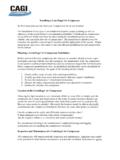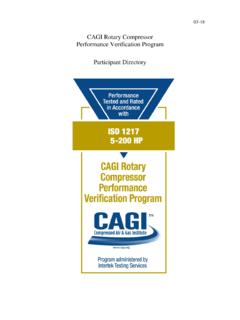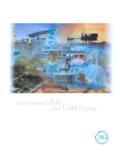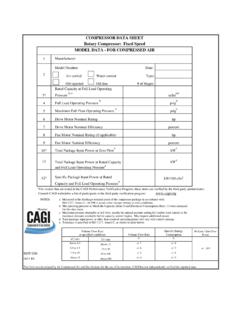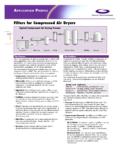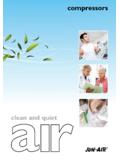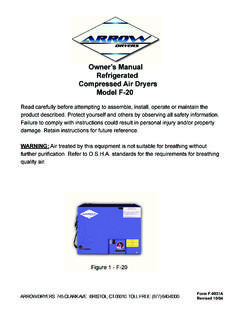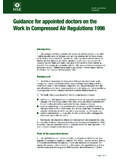Transcription of What is Clean, Dry Air? - Compressed Air and Gas …
1 TAP #106 what is clean , dry air ? Atmospheric air is composed of countless contaminants consisting of unwanted gases, liquid droplets, and particles. Air is the universal diffuser, as water is the universal solvent. Essentially all gases, vapors, and aerosols small enough to be suspended enter the atmosphere eventually. The atmosphere transports the entrained components, quite often over long distances, until they return to the earth s ecosystem. Air is composed of a multitude of gases, vapors, and aerosols that all vary in concentration, depending on time, location of nearby sources, etc. In addition, the definition of a contaminant depends on the application. Airborne pollen, for example, is a boon to vegetation (and is certainly not a contaminant) as it is transported from one location to another.
2 But it can also be a plague to animals or humans with respiratory ailments. Similarly, water vapor in the air we breathe is essential to keep the mucous glands moist, but it also breeds harmful microbes and contributes to metal corrosion. Contaminants in Compressed air systems are also defined by how the air is used. Because of this, Compressed air requirements in various industries and laboratories vary considerably and are quite different from the requirements for the air people breathe. So the purification method needed for any particular application will depend on the specific requirements for that application. The first concern in the treatment of air is the reduction or elimination of aerosols (any suspension of fine solid or liquid particles in gas).
3 Relatively large dust particles (over 100 microns in size) are easily removed in screen strainers and coarse panel filters. Particles below 100 microns require finer filtration. These particles are smaller than the width of a human hair, and are too small to be seen individually by the human eye. Particles of this size, often generated from road dust or volcanic eruptions, have been known to remain in suspension in the atmosphere for more than a year. Most of these particles can be removed by dust filters with a rating of 5 microns and larger. Finer aerosols and mists require even better filtration, often as low as micron. Microbes require absolute filtration for their removal, where the largest pore size in the filtration media is less than the smallest microbe present.
4 Liquid aerosols are removed by coalescing filters, which are composed of several media layers. The first layer consists of a fine pore media to retain the particulate contaminant and remove the fine liquid aerosols. The liquid collected on the first layer coalesces into droplets as it migrates through the media. A second layer of coarser grade media with larger pores causes the liquid to agglomerate into larger droplets. In the outer layer, the drainage media, droplets collect and flow by gravity in narrow rivulets into a collection sump below the filter. Some type of drainage device is required to continually remove the liquid collected in the drainage sump. Written by Donald White and Clemens Heinrici, Donaldson Company, Inc.
5 TAP #106 Gaseous and vaporous contaminants are reduced or eliminated by thermal or adsorptive devices. The choice of treatment again depends on the application, as this defines what components are harmful and the degree of purification required. In Compressed air applications, the compression process also tends to increase contaminant concentrations. Because of the increase in concentration, the system can become more susceptible to contaminant fouling and corrosion. The paragraphs that follow describe a number of Compressed air applications, possible contamination issues, and some of their very specific Compressed air requirements. Energy Converters Energy converters require clean , dry air for cooling and, in some cases, for the supply of oxygen.
6 Water vapor, hydrocarbons, carbon dioxide, hydrogen sulfide, nitrogen oxides and sulfur oxides reduce the efficiency of the energy converter and can lead to premature equipment failures due to surface fouling and overheating. Lasers, an acronym for light amplification by stimulated emission of radiation, are used in many printing, metal cutting, and welding devices. High intensity light generated in the resonator is sharply focused by optical lenses into a very narrow beam. Compressed air is normally used to cool the resonator. The length of the resonator (the distance between the stenotic lenses), affects the required purification level. The contaminate gases and vapors are primarily triatomic and exhibit strong polarization effects.
7 Water vapor is highly polar, and carbon dioxide is a strong dipolar gas. Electromagnetic energy of light is easily absorbed by the contaminant gases, similar to water in a microwave oven, resulting in an elevation in temperature between the lenses and a significant loss of energy from the laser system. In high concentrations, a rise in temperature can be sufficient to fracture the glass lenses. Also, aerosol contamination from dust and oil mist can agglomerate on the lens, distorting and reflecting the beams of light. This can also result in overheating and lens breakage. Fine filtration is required to keep the lenses free of contamination reduce moisture content. For short length resonators, such as those used in printing devices, filtered +40 F dry air is sufficient.
8 For long resonators typically used in welding and cutting devices, Zero-Air is required. This has less than ppmw hydrocarbon vapor, -100 F dew point air, and less than 1 ppmw carbon dioxide. (Note: The dew point is the temperature at which water vapor will begin to condense.) In sum, the quality of the air used in a laser cooling system has a significant effect on its efficiency and durability. Fuel cells, another form of energy conversion, are affected by the quality of the natural gas used to provide hydrogen, the purity of the hydrogen gas fed to the fuel cell, and the contamination level of the air providing oxygen that combines with hydrogen to produce electricity in the fuel cell. Fuel cell membranes are fouled by very small quantities of contaminant gases including the odorant in natural gas, water vapor, carbon dioxide, carbon monoxide, nitrogen oxides, and sulfur compounds.
9 As a result, fuel cells require very pure hydrogen and oxygen, plus Absolute Air (having a moisture dew point below 100 F, a carbon dioxide level below 100 ppbw, and NOX and SOX levels below 10 ppbw). With proper purification of the system gases, high efficiency and long life of the fuel cell converter is assured. Ozone, microwave, and plasma generators, as well as high voltage electrical transformers require 40 F dew point dry air to prevent corrosion and insulation break-down. Electrical transformers in Canada normally use high-pressure air to accomplish this, as opposed to insulating oil typically used in the USA. TAP #106 Electrical Generators in power plants use hydrogen gas at slightly elevated pressure to reduce windage losses between the rotor and stator of the generator.
10 Hydrogen, being a very low density gas, provides an almost frictionless gap between the two generator components. This hydrogen must be dry and aerosol free. Moisture in the hydrogen gas has been found to be problematic, as it can cause significant corrosion of the high voltage terminal strip. Drying hydrogen to -40 F dew point has eliminated these types of corrosion problems. Pneumatic Power Air motors use Compressed air to power tools ranging from dental drills to roadside jackhammers. Air motors also serve as starting engines for large compressors and shipboard power plants. They provide very light, versatile drives for countless services. Energy is extracted thermally from Compressed air and a large temperature reduction occurs adiabatically from the expansion of the air through the motor.


